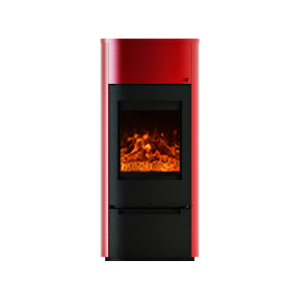Freestanding round fireplaces have become popular choices for both modern and traditional interiors, offering an attractive focal point while providing warmth and ambiance. Their distinctive round shape not only adds aesthetic appeal but also offers functional benefits such as efficient heat distribution. A critical factor influencing their performance, durability, and design is the selection of materials used in their construction.

The foundation of any freestanding round fireplace lies in its structural materials. These materials must withstand high temperatures, mechanical stresses, and prolonged use while maintaining stability and safety.
1. Steel
Steel is among the commonly used materials for the main body and frame of freestanding round fireplaces.
Advantages:
High strength and durability.
Good heat resistance, allowing the fireplace to withstand continuous operation at elevated temperatures.
Versatility in fabrication, enabling the creation of smooth, curved surfaces essential for the round design.
Good thermal conductivity, facilitating efficient heat radiation into the room.
Common Types:
Mild steel is typically used for budget-friendly models.
Stainless steel is favored for higher-end fireplaces due to its corrosion resistance and sleek appearance.
Steel components are often powder-coated or painted with heat-resistant finishes to prevent rust and enhance visual appeal.
2. Cast Iron
Cast iron is another traditional material used especially for parts requiring heat retention.
Benefits:
Exceptional ability to absorb and radiate heat slowly, providing lasting warmth even after the fire dies down.
High durability and resistance to deformation under heat.
However, cast iron is heavier and more brittle than steel, which can affect portability and design flexibility. Some freestanding round fireplaces combine cast iron with steel to balance strength and heat retention.
Fire Chamber and Lining Materials
The fire chamber is the area where combustion takes place, so materials used here must resist direct flame, high heat, and thermal shock.
3. Firebrick and Refractory Ceramic
Firebricks or refractory ceramics are commonly used to line the inner walls of the fire chamber.
Purpose:
Protect the fireplace body from intense heat and reduce wear.
Improve combustion efficiency by reflecting heat back into the fire and maintaining a stable temperature.
Reduce emissions by promoting complete fuel combustion.
These materials are specifically designed to tolerate temperatures often exceeding 1000°C without cracking or degrading.
Glass Components
Modern freestanding round fireplaces often feature glass doors or panels that allow viewing of the fire while maintaining safety and controlling airflow.
4. Ceramic Glass
Ceramic glass is the preferred material due to its heat resistance.
Features:
Can withstand direct flame and temperatures above 700°C.
Provides a clear, durable viewing window that does not discolor easily.
Offers safety by containing sparks and embers within the fire chamber.
This type of glass is specially treated to endure thermal expansion and sudden temperature changes without breaking.
Insulation Materials
To enhance safety and efficiency, insulation is used in some freestanding round fireplaces, particularly between the fire chamber and the outer body.
5. Mineral Wool and Ceramic Fiber
Mineral wool or ceramic fiber insulation materials are often employed.
Role:
Minimize heat transfer to the outer surface, reducing the risk of burns and damage to nearby objects.
Improve heat retention within the fire chamber, increasing fuel efficiency.
Contribute to quieter operation by damping vibrations and reducing noise.
These insulation materials are lightweight, heat resistant, and easy to install, making them ideal for freestanding fireplace designs.








